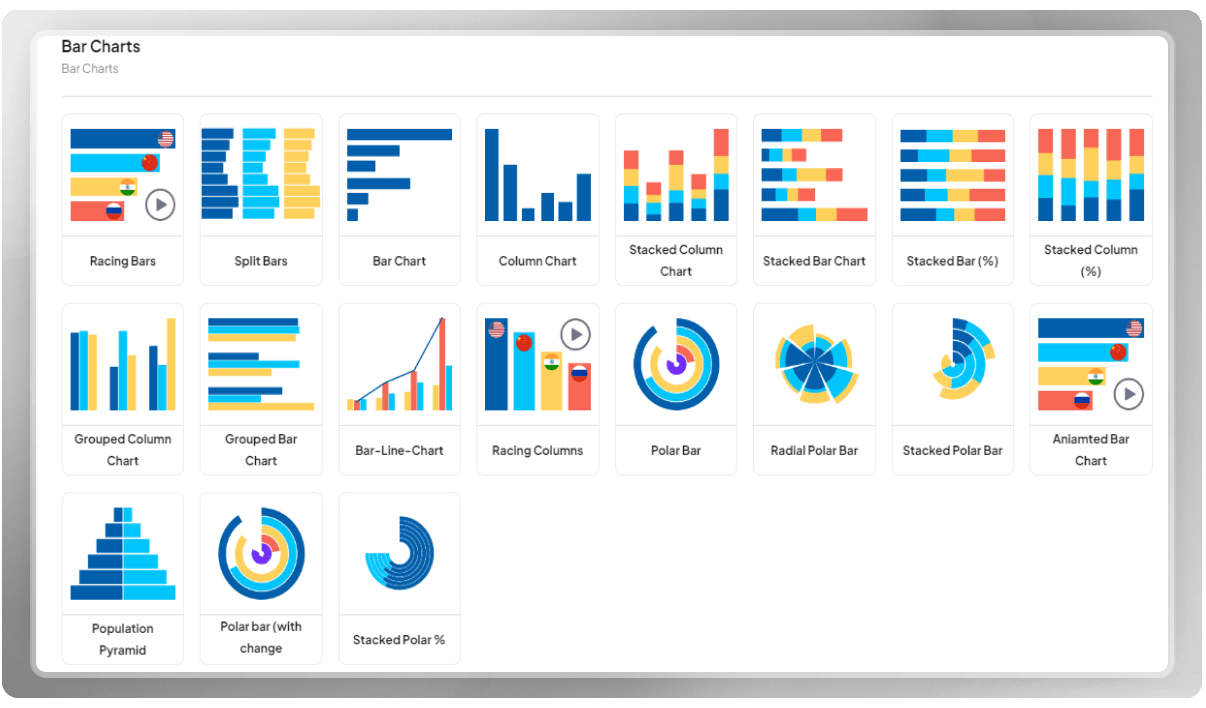Bar Charts 101: A Guide to Creating Compelling Bar Charts

When it comes to data visualization, the name of bar charts usually comes to mind. The reason lies in the popularity and the simplicity of its design, making it one of the most common visualizations among the others. Using a well-designed bar chart, you can simply convey your information to your audience.
For instance, the following chart shows the list of the best-selling cars in the first quarter of 2023 worldwide.
In the following article, you will delve into the world of bar charts and explore their significance, best applications, and various types. Read on to learn more.
What is a Bar Chart
A bar chart (or a bar graph) is a form of data visualization in which the data is represented via rectangular bars. Each bar displays values related to different categories, and the length and height (in column charts) of the bar represent the value associated with that category. The bars can be oriented either vertically or horizontally, depending on the presentation style.
Bar charts are particularly effective for comparing data across different categories and identifying trends, patterns, and disparities within the dataset. They are especially useful when dealing with categorical or discrete data, where the categories have distinct labels and do not have a continuous relationship between them.
If you wish to visualize the price of Cappuccino in restaurants for a presentation, you can create something like the chart below.
The significance of bar charts in data visualization
In the world of visualization, bar charts offer a clear representation of comparisons, trends, and distributions within a dataset. By using simple rectangular bars, bar charts make it easy for viewers to grasp the relative sizes and relationships of data points quickly. Whether you're presenting financial data, survey results, or any other categorical information, bar charts provide an intuitive solution for conveying insights.
Bar charts are particularly useful for illustrating trends over time, comparing quantities across various groups, and highlighting significant variations or outliers. Business analysts use bar charts to present sales data, marketers employ them to showcase customer preferences, and researchers utilize them to visualize survey responses. Bar charts are also widely used in educational contexts to help students understand data distributions and relationships.
As in the case of the following population pyramid, which is a type of bar chart, you can extract insights and compare the two categories together.
Ideal data types for bar charts
The best type of data to visualize using bar charts is categorical data, which consists of distinct, non-numeric categories. These categories could be anything from months of the year to types of products or geographic regions. In addition, you can use both nominal data (categories with no inherent order) and ordinal data (categories with a specific order). This versatility makes bar charts a valuable tool in many applications.
Different types of bar charts
There are various types of bar charts, including vertical bar charts (or, as we call them in PlotSet, Column Charts), horizontal bar charts, grouped bar charts, stacked bar charts, and more. The choice of chart type depends on the specific data and the insights you want to convey. Vertical bar charts or column charts are commonly used to display data, with the x-axis representing the categories and the y-axis representing the values. Horizontal bar charts invert this arrangement, with the categories on the y-axis and the values on the x-axis.
Horizontal bar charts
In this type of visualization, the bars run horizontally along the x-axis. In the chart you can see above, you can see a visual representation of how the number of Nike retail stores has evolved over the specified timeframe.
The y-axis represents the years, starting from 2009 and progressing through 2023. The x-axis illustrates the change in the count of Nike retail stores from year to year. Each bar's length corresponds to the number of retail stores in the corresponding year. A longer bar indicates a higher store count, while a shorter bar reflects a lower count.
This bar chart is effective in illustrating trends and patterns in the expansion or reduction of Nike retail stores globally over the specified period.
In general, the best thing about a bar chart is that it provides a visual representation that is easily interpretable, making it a fundamental tool for data analysts, researchers, and communicators to effectively convey information, compare data points, and make data-driven decisions.
Column chart
A column chart is the most common type of bar chart. You can recognize a column chart where the bars run vertically along the y-axis. The chart above has been visualized using a column chart displaying NBA All-time Playoff Scoring Leaders as of June 2023. By looking at this visualization, you can detect the top playoff scorers in the history of the National Basketball Association.
Here, the x-axis represents the names of the players who have achieved the status of all-time playoff scoring leaders. Each player's name is placed along the x-axis in an organized manner. The y-axis displays the playoff points scored by each player.
Each column corresponds to a specific player, and its height reflects the total number of playoff points that player has scored. Taller columns indicate higher cumulative scores, signifying the players' prolific scoring abilities in the NBA playoffs.
With the help of a column chart, you can easily create a visualization that is straightforward and easy to understand. Column charts are especially effective when dealing with categorical data, where each category is represented by a distinct column.
In addition, the vertical columns have a strong visual impact, making it easy for the audience to grasp the key insights from the data quickly. Due to their simplicity, column charts are accessible to a wide range of audiences, including those with varying levels of data literacy.
Stacked bar chart
A stacked bar chart displays the distribution of a categorical variable across multiple sub-categories while also showcasing the composition of each category as a whole. Individual data values in this chart are represented as segments of a bar, and these segments are stacked on top of one another to create a full bar.
Each bar in a stacked bar chart represents a category, and the segments within that bar represent different subcategories of that category. The height of the bar represents the total value of the category, while the lengths of the individual segments represent the proportions of each subcategory within that category.
For instance, in the chart above, you can see the distribution of different employment statuses (such as remote work, paid leave, unemployment, etc.) within various economic sectors during the time of the pandemic. The chart would allow viewers to see how the composition of employment statuses differs across sectors and how they change over time.
A stacked bar chart is best for illustrating how different parts contribute to a whole and comparing the relative sizes of subcategories within different categories. They are commonly used to showcase data with multiple variables or dimensions that can be broken down into discrete components.
Grouped bar chart
A grouped bar cart presents multiple bars side by side, with each group of bars representing a specific category and each individual bar within the group representing a different subcategory. You can use a group bar chart to compare the values of different subcategories.
In a grouped bar chart, the bars within each group are usually grouped closely together, making it easy to visually compare the values of the same subcategory across different categories. The grouping of bars allows for direct comparison between different subcategories within each category, as well as the subcategories.
When you want to showcase the relationships between multiple categories and their corresponding subcategories, you can use a grouped bar chart. For instance, the chart above showcases yoga popularity across different countries, with a focus on the percentage of male and female yoga enthusiasts. The visualization aims to provide insights into gender distribution within the yoga community across various geographic locations.
Using PlotSet to visualize your bar charts

If you're looking to create a bar chart or its other variants, you can use PlotSet. PlotSet is a straightforward data visualization tool offering over one hundred templates. As for bar charts, you can access different types of them in the panel (even the ones not mentioned in the article), including:
- Racing Bars
- Split Bars
- Bar Chart
- Column Chart
- Stacked Column Chart
- and more.
Easily visualize your data with PlotSet!
